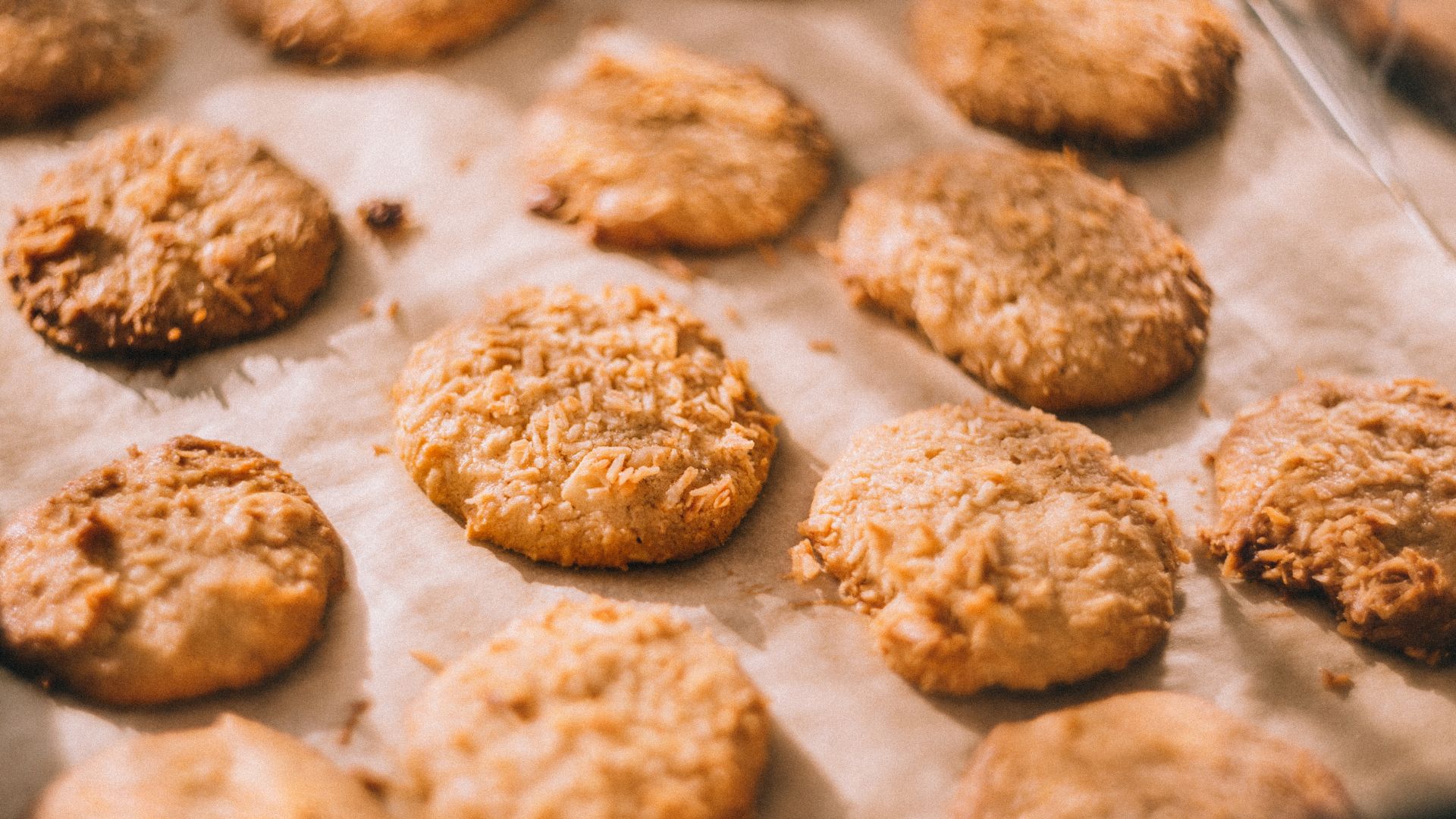In this blog, I’ll talk about my journey with gluten-free blends, especially their role in cookie making. Having navigated the world of gluten-free baking, I’ve come to appreciate the nuances that make gluten-free blends essential for crafting delicious and texturally pleasing cookies.
Table of Contents
ToggleWhat is a Gluten-Free Blend (GB)?
A gluten-free blend is a mixture of various gluten-free flours and other ingredients designed to mimic the properties of wheat flour in baking. Unlike wheat flour, which contains gluten – a protein that gives baked goods their structure and chew – gluten-free blends aim to provide similar texture and consistency.
These blends typically include a combination of rice flour, tapioca starch, potato flour, and sometimes xanthan gum or guar gum. Each component plays a specific role: == >> Check out the right cookies Gluten-Free Blend, tools, and ingredients that you need here
- Rice Flour: Adds bulk and texture.
- Tapioca Starch: Improves elasticity and chewiness.
- Potato Flour: Helps with moisture retention and binding.
- Xanthan Gum or Guar Gum: Acts as a binding agent to replicate gluten’s elasticity.
The exact ratio of these ingredients can vary between brands and recipes, but the goal remains the same: to produce a flour that behaves like wheat flour in baking.== >> Check out the right cookies Gluten-Free Blend, tools, and ingredients that you need here

Why Use a Gluten-Free Blend for Cookies?
When baking cookies, gluten plays a crucial role in creating the structure and texture. Since gluten-free flours lack gluten, using a dedicated blend is essential for achieving similar results. Here’s why:
1. Texture and Consistency
Gluten-free blends are formulated to ensure that cookies have the right texture. Without gluten, cookies can turn out crumbly or too dense. A good gluten-free blend provides the necessary binding agents and starches to keep cookies tender yet chewy.== >> Check out the right cookies Gluten-Free Blend, tools, and ingredients that you need here
2. Flavor Balance
Gluten-free flours often have distinct flavors, which can be more pronounced in baked goods. A well-balanced gluten-free blend combines different flours to create a neutral flavor, allowing the cookie’s other ingredients – like chocolate chips or nuts – to shine through.
3. Consistency in Results
Using a pre-made gluten-free blend simplifies the baking process. It ensures consistent results, as these blends are crafted to deliver reliable performance. This consistency is especially valuable if you’re new to gluten-free baking.== >> Check out the right cookies Gluten-Free Blend, tools, and ingredients that you need here
Tips for Baking Gluten-Free Cookies
If you’re diving into gluten-free cookie baking, here are a few tips to get the best results:
- Measure Accurately: Gluten-free flours can be more variable in density than wheat flour, so accurate measurement is key.
- Follow the Recipe: Gluten-free baking can be a bit more finicky. Stick closely to the recipe, especially when it comes to ingredient proportions.
- Allow Time for Resting: Some gluten-free cookie doughs benefit from resting in the refrigerator before baking. This helps the flours hydrate and improves the cookie’s texture.== >> Check out the right cookies Gluten-Free Blend, tools, and ingredients that you need here

Ingredients On Table
Examples of Gluten-Free Blends and How They Affect Cookie Recipes
Understanding how different gluten-free blends impact your cookie recipes can make a huge difference. Here are some popular gluten-free blends and how they can influence your baking results:
1. Bob’s Red Mill Gluten-Free 1-to-1 Baking Flour
This blend is a favorite among many gluten-free bakers because it is designed to substitute directly for all-purpose flour in recipes. It includes a mix of rice flour, potato starch, and tapioca flour, along with xanthan gum.== >> Check out the right cookies Gluten-Free Blend, tools, and ingredients that you need here
Impact on Cookies:
- Texture: Provides a balanced texture, similar to what you’d get with traditional flour.
- Flavor: Generally neutral, so it won’t overpower the other flavors in your cookies.
- Best For: Chocolate chip cookies, sugar cookies, and other classic cookie recipes.
2. King Arthur Gluten-Free Measure for Measure Flour
King Arthur’s blend also aims to replace all-purpose flour directly. It combines rice flour, tapioca starch, and potato starch with guar gum.
Impact on Cookies:
- Texture: Known for giving cookies a nice, chewy texture with a tender crumb.
- Flavor: Mild and versatile, working well with various types of cookies.
- Best For: Oatmeal cookies, snickerdoodles, and gingerbread.
3. Cup4Cup Gluten-Free Flour
Cup4Cup is designed by chefs to mimic the performance of wheat flour. It contains a blend of cornstarch, white rice flour, brown rice flour, and milk powder.== >> Check out the right cookies Gluten-Free Blend, tools, and ingredients that you need here
Impact on Cookies:
- Texture: Often provides a slightly denser and richer texture, which can be great for cookies that need a bit more substance.
- Flavor: Subtle flavor profile that complements many cookie recipes.
- Best For: Dense cookies like biscotti or rich, buttery cookies.
Adapting Your Favorite Recipes
If you have a favorite cookie recipe that you want to make gluten-free, here are a few tips on how to adapt it:
1. Substitute Directly with a Gluten-Free Blend
If you’re using a gluten-free blend designed to replace all-purpose flour, you can usually substitute it 1:1. However, you may need to adjust other ingredients like leavening agents or liquids, depending on the blend’s characteristics.
2. Adjust for Texture
Different gluten-free blends can behave differently. If your cookies turn out too crumbly or dry, try adding a bit more moisture (like an extra egg or a tablespoon of oil) or adjusting the baking time.== >> Check out the right cookies Gluten-Free Blend, tools, and ingredients that you need here
3. Experiment with Additional Ingredients
To improve the texture, you might experiment with adding a small amount of xanthan gum or guar gum if your blend doesn’t already include them. This can help mimic the elasticity and binding properties of gluten.
Drilling Deeper: Comparing Gluten-Free Blends vs. Traditional Flour
When diving into gluten-free baking, it’s helpful to understand how gluten-free blends stack up against traditional wheat flour. Let’s break down the key differences and similarities to give you a clearer picture of what each brings to your cookie recipes.
Gluten-Free Blends vs. Traditional All-Purpose Flour
1. Texture and Structure
Traditional Flour:
- Contains Gluten: Gluten provides elasticity and structure, making cookies chewy and giving them a well-defined shape.
- Consistent Results: Traditional flour usually results in predictable texture and rise in cookies.
Gluten-Free Blends:
- No Gluten: These blends use a combination of starches and proteins to replicate the properties of gluten. This can result in different textures – sometimes too crumbly or too dense if not properly balanced.
- Variable Results: Depending on the blend and recipe, the texture might vary. Some blends are designed to closely mimic wheat flour, while others may lead to unexpected results.
2. Flavor Profile
Traditional Flour:
- Neutral Flavor: Generally, wheat flour has a mild, neutral flavor that blends well with other ingredients in cookies.
Gluten-Free Blends:
- Flavor Variability: The taste can vary depending on the blend. For instance, some gluten-free flours have a more pronounced flavor (like rice flour), while others are more neutral. High-quality blends aim to minimize any off-flavors and provide a more neutral taste.
3. Binding and Leavening
Traditional Flour:
- Built-in Binding: Gluten acts as a natural binder, helping ingredients stick together and rise properly.
Gluten-Free Blends:
- Added Binders: To replace gluten’s binding properties, gluten-free blends often include gums (like xanthan or guar gum) or additional starches. These ingredients help mimic gluten’s effects but can sometimes lead to a different texture or consistency.== >> Check out the right cookies Gluten-Free Blend, tools, and ingredients that you need here
4. Nutritional Content
Traditional Flour:
- Higher in Protein: Wheat flour contains gluten, which is a protein, contributing to the overall protein content of the baked goods.
Gluten-Free Blends:
- Varied Nutrition: Nutritional content can vary based on the blend’s ingredients. Some gluten-free flours are lower in protein but might be higher in carbs or fats. Always check the nutritional label to understand what you’re getting.
5. Shelf Life and Storage
Traditional Flour:
- Stable: Regular wheat flour has a relatively long shelf life and can be stored at room temperature without special considerations.
Gluten-Free Blends:
- Potentially Shorter Shelf Life: Some gluten-free blends may have a shorter shelf life and might need to be stored in a cool, dry place or even refrigerated. Always check the blend’s packaging for storage recommendations.== >> Check out the right cookies Gluten-Free Blend, tools, and ingredients that you need here
Pros and Cons: Gluten-Free Blends vs. Traditional Flour
Gluten-Free Blends:
Pros:
- Essential for Gluten-Free Diets: Necessary for individuals with celiac disease or gluten intolerance.
- Versatile: Many blends are designed to mimic traditional flour and can work well in various recipes.
Cons:
- Can Be Expensive: Gluten-free blends can be more costly than regular flour.
- Inconsistent Results: Some blends may yield unpredictable results in texture or flavor.
Traditional Flour:
Pros:
- Reliable: Provides consistent texture and flavor in recipes.
- Cost-Effective: Generally cheaper than gluten-free blends.
Cons:
- Not Suitable for Gluten-Free Diets: Not an option for those with gluten sensitivities or allergies.
- Limited to Wheat-Based Recipes: Not suitable for individuals who must avoid gluten for health reasons.== >> Check out the right cookies Gluten-Free Blend, tools, and ingredients that you need here
Comparison Table: Gluten-Free Blends vs. Traditional Flour
| Aspect | Gluten-Free Blends | Traditional Flour |
|---|---|---|
| Texture and Structure | Uses starches and proteins to mimic gluten; may vary in texture (crumbly or dense) | Contains gluten for elasticity; consistent texture and structure |
| Flavor Profile | Can have distinct flavors depending on blend; high-quality blends aim for neutrality | Generally neutral, blends well with other ingredients |
| Binding and Leavening | Requires added binders (e.g., xanthan gum) to mimic gluten’s binding properties | Gluten acts as a natural binder and provides structure |
| Nutritional Content | Varies widely; some blends may be lower in protein but higher in carbs or fats | Higher in protein; more consistent nutritional profile |
| Shelf Life and Storage | May have a shorter shelf life; often needs cool, dry storage or refrigeration | Long shelf life; stable at room temperature |
| Cost | Typically more expensive than traditional flour | Generally more affordable and cost-effective |
| Dietary Suitability | Essential for individuals with celiac disease or gluten intolerance | Not suitable for gluten-free diets |
Key Notes and Considerations
1. Texture and Structure
Gluten-Free Blends:
- Key Note: Texture can vary significantly between different blends. Some may lead to cookies that are too crumbly or dense if the blend isn’t well-balanced.
- Consideration: Testing and adjusting the recipe may be necessary to achieve the desired texture. Some blends might require additional moisture or binding agents.
Traditional Flour:
- Key Note: Provides consistent texture and structure due to the presence of gluten.
- Consideration: Ideal for those without gluten sensitivities. No adjustments are needed for texture in traditional recipes.
2. Flavor Profile
Gluten-Free Blends:
- Key Note: Flavor can differ based on the blend’s ingredients. High-quality blends are designed to have a neutral taste.
- Consideration: Be aware of the blend’s flavor impact on your cookies. Some blends may need flavor balancing with other ingredients.
Traditional Flour:
- Key Note: Has a mild, neutral flavor that complements other ingredients well.
- Consideration: No additional adjustments are usually necessary for flavor.
3. Binding and Leavening
Gluten-Free Blends:
- Key Note: Requires added binders like xanthan gum or guar gum to replace gluten’s properties.
- Consideration: Ensure your blend includes adequate binders or adjust recipes accordingly to prevent crumbly or poorly risen cookies.
Traditional Flour:
- Key Note: Natural gluten provides binding and structure.
- Consideration: No additional binders are needed. Results are more predictable with standard recipes.
4. Nutritional Content
Gluten-Free Blends:
- Key Note: Nutritional profiles can vary; some blends may be higher in sugar or fat to compensate for texture.
- Consideration: Check nutritional labels if health is a concern, and choose blends that align with dietary needs.== >> Check out the right cookies Gluten-Free Blend, tools, and ingredients that you need here
Traditional Flour:
- Key Note: Higher in protein and provides a stable nutritional profile.
- Consideration: A good option for those who do not require gluten-free diets.
5. Shelf Life and Storage
Gluten-Free Blends:
- Key Note: May have a shorter shelf life and could require refrigeration.
- Consideration: Follow storage recommendations on the packaging to maintain freshness.
Traditional Flour:
- Key Note: Generally has a longer shelf life and is more stable at room temperature.
- Consideration: Store in a cool, dry place to prevent spoilage.
6. Cost
Gluten-Free Blends:
- Key Note: Typically more expensive than traditional flour.
- Consideration: Budget for higher costs if baking gluten-free regularly.
Traditional Flour:
- Key Note: More cost-effective and widely available.
- Consideration: Economical choice for those not restricted by dietary needs.
By understanding these differences and considerations, you can better navigate the world of gluten-free baking and make informed decisions that best suit your dietary needs and baking preferences.== >> Check out the right cookies Gluten-Free Blend, tools, and ingredients that you need here

